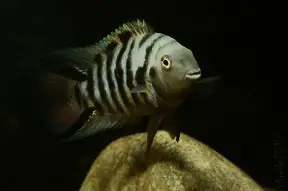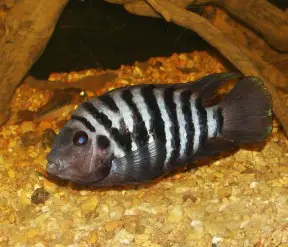Amatitlania nigrofasciata
Convict Cichlid
Classification
Order: Perciformes Family: Cichlidae
Distribution
Has a widespread distribution in Central America, being native to Guatemala, Honduras, El Salvador, Nicaragua, Costa Rica and Panama. It also exists as an introduced species in several countries, including the USA and Australia.
Habitat
Unsurprisingly, given its massive natural range, it is found in a wide variety of environments from flowing waters of rivers to ponds and lakes. It is almost never found in open water, though, preferring to stay in areas containing cover in whatever form.
Maximum Standard Length
80 – 150 mm.
Aquarium SizeTop ↑
Base dimensions of 90 cm x 30 cm or equivalent are adequate for a single pair, although we’ve seen it being bred in smaller tanks. If you want to keep multiple pairs or other cichlid species in the same tank you’d be looking at something substantially bigger.
Maintenance
Use rocks, bogwood and roots to provide plenty of hiding places and potential spawning sites for the fish. You may also wish to provide additional caves in the form of suitably sized clay flower pots laid on their side. Plants can be used but may be uprooted by the fish, as they are avid diggers.
Water Conditions
Temperature: Tolerant of a fairly wide temperature range but a value of 24 – 28 °C is recommended for long-term aquarium care.
pH: 6.0 – 8.0. Somwhere on the alkaline side of neutral is ideal.
Hardness: 90 – 447 ppm
Diet
Very unfussy and will accept most foods offered. Try to keep the diet varied for the fish to develop the best condition.
Behaviour and CompatibilityTop ↑
Simply put, not a good community fish. Unfortunately it’s often sold as such. Although a great beginners species in many ways, it is best maintained in a species tank. It is an aggressive, territorial species that becomes downright violent when breeding. It will take on fish several times its own size and win with ease. In a very big tank you can keep it in a community of robust Central American cichlids.
Sexual Dimorphism
Males tend to grow larger than females and grow pointed dorsal and anal fins as they mature. Some specimens also develop a nuchal hump. Females have a characteristic dark spot in the dorsal fin and are more brightly coloured when in spawning condition.
Reproduction
One of the most easily-bred species in the hobby, it’s ideal for the newcomer to cichlids and fish breeding in general.
Pairing is often as easy as dropping a male and a female into a tank together. If this fails buy a group of juveniles and grow them on together. Unless you’re using a large tank, be prepared to move the surplus specimens once a pair has formed, as the male in particular will not tolerate other fish in his territory. If space is not an issue, you may find that additional pairs form in other parts of the tank. The tank itself should be set up as suggested above, with plenty of caves and hiding places. Add some clay flowerpots to act as potential spawning sites. Condition the fish on a varied diet and perform large (up to 50%) weekly water changes to encourage them to spawn.
When ready to spawn, both fish will intensify in colour. The female will select and then clean a spawning site. Following some courtship displays, as many as 300 eggs will be laid. The female takes responsibility for guarding and tending them, while the male patrols the perimeters of the territory, keeping all-comers at bay. For a small fish they are surprisingly aggressive, and will even attack an unwary finger at this point.
The eggs hatch in 3-4 days and the fry drop to the floor of the cave. They are then moved into a pre-excavated pit in the substrate, where they remain until their yolk sacs are absorbed. Some pairs may move the fry to other pits over the course of the next 4-7days, after which they become free swimming. Feed them on brineshrimp nauplii from this point, moving them onto crushed flake and cichlid pellets as they grow. They will also graze on algae and detritus they find in the tank. Parental care is excellent and continues for several weeks. The young tend to congregate around the female while the male continues to protect the territory from intruders.
NotesTop ↑
A hugely popular and very adaptable species, the convict is one of the most ubiquitous fish in the hobby. It is often referred to by synonyms such as Cryptoheros nigrofasciatus and Cichlasoma nigrofasciatus. It’s difficult to know how much to recommend it to the beginner, as despite its hardiness and ease of breeding, it’s not really a community fish. However, if you want to breed a species and witness some amazing parental behaviour, it’s an unreserved recommendation. It now exists in several man-made colour forms, including the popular pink form, as well as long-finned and marbled varieties.
If you do get a breeding pair going, be warned that the fry are not easy to dispose of. These are so easily-bred and productive that many dealers will not accept them. Consequently, they do not fetch a good price, either.



November 28th, 2014 at 8:01 pm
Great fish to own.
If you need to slow down the breeding, which can happen every 2 weeks if you remove the fry, just turn the temperature down to 24 degrees.
March 29th, 2017 at 6:10 pm
What about the species A. nanolutea? aka. “Gold Convict”